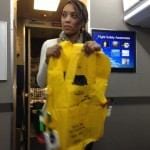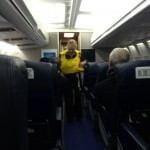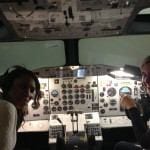Part of being the Travel Detective is training six times a year in cockpit simulators as well as cabin simulators. On a recent trip to London, British Airways presented the ABC’s of aircraft safety – including emergency evacuation down the slides. Follow along as Peter and Travel Correspondent Alyssa Caverley take on the British Airways Flight Safety Awareness Course.
In the cabin: We experienced a simulated flight emergency on a full-motion Boeing 737 cabin simulator. Throughout the course, we learned important safety advice and techniques, like what to do when a flight attendant is shouting “BRACE, BRACE”, the proper brace position (it’s one hand over the other and head down as low as you can get in your seat), and some tips on how to best plan your personal course of action in the case of an emergency — would you know where the exit is if you are blinded by a cabin filling up with smoke? Count the rows to the emergency exit when you get on the plane!
There are different emergencies on board an aircraft and various responses to each one. We learned about ditching, which is when an aircraft lands on water; an emergency landing, which is when the airplane has to land quickly on land; and the the proper protocol for decompression, including the use of oxygen masks.
Crash simulation: We learned the safety basics as well as what to do in extreme hazards, like life-threatening smoke in the cabin. There are many different hazards on board an aircraft in the event of an emergency and knowing how to handle each one will make you a safer traveler. We learned the process of a full aircraft evacuation amid a smoke-filled environment, which includes the door and overwing exit operations on a Boeing 737.
Emergency Evacuation: The course ended with what to do when the airplane actually lands in an emergency. The flight attendants will usually be the ones opening the emergency door, both at the front and rear of the cabin, but do you really know how to open the emergency exits at the seats. They are heavy! We learned how to properly open the doors, what to do if you are the one handling the exit and there are 200 people trying to push you out (note: hang on to the handle inside the aircraft!), and how to release the evacuation slide.
Getting out of the plane: For an emergency landing on both land and water, the slide will be released and you will have to use that slide to evacuate the aircraft. There is a proper way to go down — cross your arms and lean forward to prevent any injuries at the bottom as you are moving pretty quickly. We got a chance to experience the slide that descends from the aircraft – and you are flying! Knowing the proper protocol and body position will help you get out safely.
The course is not meant to scare you — and it shouldn’t. It is meant to make you a more informed and safer traveler. Frequent flyers usually fail to pay attention to the safety announcement at the beginning of every flight — but in the case of an emergency when your adrenaline is pumping and you are not thinking clearly, will you remember the video you half listened to at the beginning of the flight? Flying is very safe and it’s very rare to have to land in an emergency, but it could happen. Being able to handle those situations and do it in a clear frame of mind is important.
After the BA flight, that is just what happened. We are more informed travelers.
By Alyssa Caverley and Peter Greenberg for PeterGreenberg.com


















